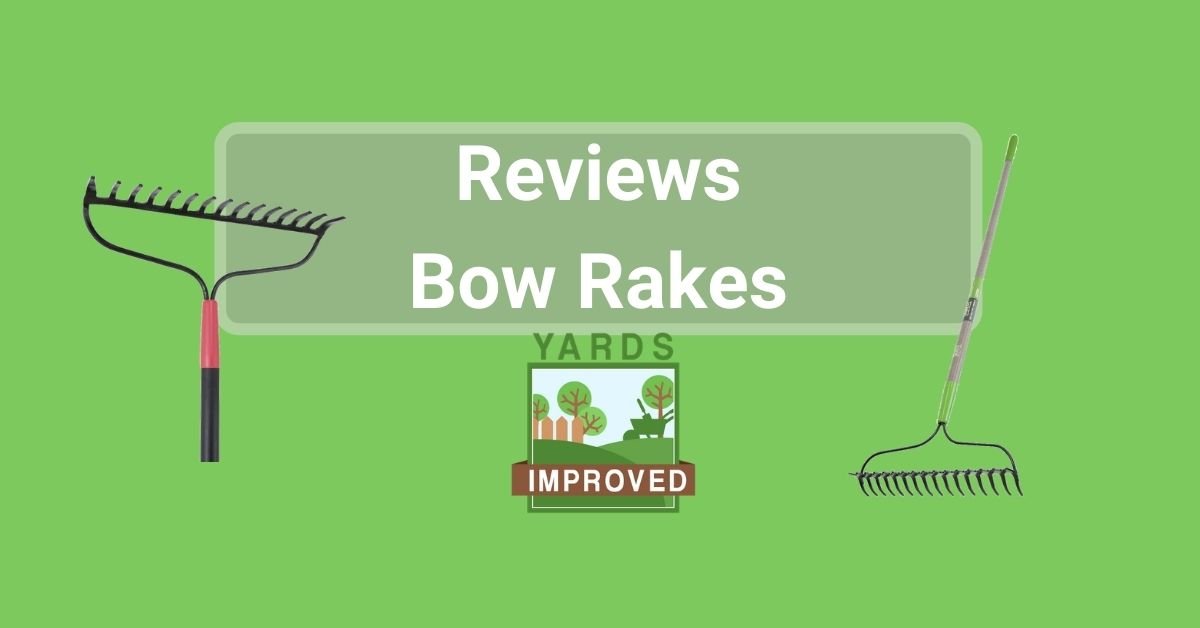When you need to level soil or break up clumps, it’s time to pull the bow rake out of the shed. This tough tool can even make easy work of spreading driveway gravel. But if you don’t have one yet, or your current bow rake is ready to retire after years of faithful service, you need to know how to pick a new one.
What Is A Bow Rake Or Garden Rake
Like so many things in the English language, a bow rake also has a variety of other names. At times it’s called a garden rake. We’ve also seen them referred to as landscaping rakes, although these are generally wider than a typical bow rake. “Level headed” rakes are similar in function but have a different design.
A bow rake is almost always made with a metal head and tines because it’s intended for heavy-duty work. It has a series of straight tines – usually 14-16 of them. The tines are all the same length and are parallel to each other. They measure two to three inches long. They attach to a cross piece that’s around 14 to 18 inches wide.
The name “bow rake” comes from the shape of the head. The bar with the tines joins two pieces of metal at either side. These curve back to the middle and connect to the handle. Those two curved pieces look like an archery bow, and the crossbar resembles the bowstring.
This type of rake has a long handle. It may be made of wood, fiberglass, or metal.
A bow rake can help level soil and break up larger chunks. They can also spread gravel. They aren’t great for raking dry leaves since the tines tend to pierce through the leaves and get clogged quickly – it’s better to stick to a leaf rake for that. But if you have to rake wet leaves or move compost, a bow rake will serve you well.
What To Look For In A Garden Rake
The chief quality you want in a bow rake is durability. Since you’ll be pulling it through soil, mulch, or stone, you need a tool that will hold up under the weight. You also want to be sure it won’t break if it gets snagged on a root or heavier rock.
As we mentioned, the bow and tines are usually made of steel, although there are some from tough aluminum, too. Of course, there are likely other types out there too, but it’s important to be sure the tines aren’t going to snap off.
The fewer welds in the head of the rake, the better. Cast or forged pieces offer less chance for something to break.
Need other tools for your yard work? Check out the basics that should be in every shed!
You’ll also want to look at how the head attaches to the handle. Usually, the two metal frame pieces slide into a socket, called a ferrule, at the end of the handle. Their own outward pressure is strong enough against the inside of the ferrule to keep it from coming loose.
Finally, the handle should be as comfortable as possible. Like most tools, the handles are generally 56” to 58” long. Many have a rubber or foam pad for your hands. Some even have a “teardrop” shape, meaning they are wider at the top and narrow slightly to contour to the typical hand shape. This is generally a matter of personal preference.
Our Picks for the Best Garden Rakes
A good bow rake can help you get a lot done. There are many on the market, but a few stand out for their dependability. Let’s have a look at them.
Razor-Back 15-Tine Forged Bow Rake
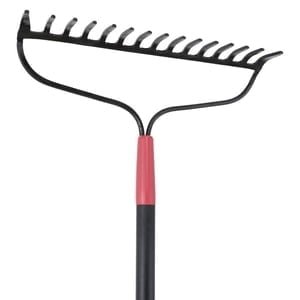
This rake from Razor-back features a forged-steel head. The ferrule is also made of steel.
The total width of the rake head is 16 ⅜ inches. It has 15 tines in all.
The handle is made of wood with a fiberglass coating. It has additional cushioning for the hands as well. The handle itself measures 60 ¾”. Including the head, it’s 66 ½”. That’s the longest handle and total tool length we’ve seen. If you’re on the tall side, you want to consider this rake!
It’s sturdy and somewhat heavy at about 3 ⅓ pounds.
Overall, we found it to be a good rake and we see that the huge majority of online ratings are very positive. However, there are some complaints that the rake itself detached from the handle. It doesn’t seem to be a common issue, but it’s still worth being aware of.
The product carries a lifetime warranty.
Ames 16-Tine Double Play Bow Rake with Fiberglass Handle

This unusual rake from Ames almost doesn’t fit the definition of a bow rake. It’s still close enough for our purposes (plus, they call it a bow rake, so what can we do . . .)
What makes it unique is its two-sided head. One side has long, curved tines, which are better for breaking up clumps of dirt. The other side has shorter, straighter tines which can make leveling soil easier. Honestly, most rakes do this fine with just one set of tines, but this might make it a tiny bit easier.
The handle is 57 ½” and is made of solid fiberglass. There’s a cushion grip on the end, although it seems to just slide on – which means it could also slide off. You could probably just use a strong glue to hold it in place if you have any issues with it.
While the tines are forged to the crossbar, the crossbar itself is welded to the sidebars.
There’s a 15-year warranty on this rake.
ANViL 14-Tine Bow Rake
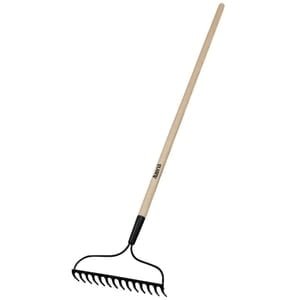
ANViL makes this 14-tine rake. The head’s made of tempered steel and it holds up well under regular use.
This is on the short side, though. The handle is only 51” long, on the short side, to say the least. The positive, though, is that it’s made of hardwood.
The head of the rake measures 13 ¾” wide and there are 14 tines. This is on the narrow side but can still get the job done.
Like any rake we’ve looked at, there are some complaints about the head breaking. Most reviews, though, say they’ve had no problems with. It’s hard to say if it was a defective piece or misuse that led to issues.
Bully Tools 58 in. 16-Tine Bow Rake with Fiberglass Handle
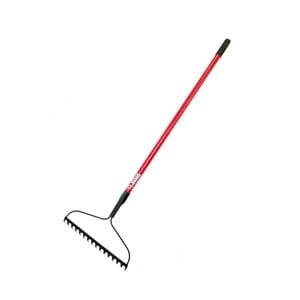
This tool from Bully Tools will make a great addition to your shed. It has a wide, 16” head with 16 tines.
The welding looks great on it, and the fiberglass handle is durable. The handle is 54.5” long, somewhat on the short side but not the shortest we’ve seen. It’s comfortable to use as far as rakes go.
The rake head is welded to the ferrule and shouldn’t present any problems as long as it’s used correctly.
It’s a bit on the heavy side at nearly 3 ½ pounds, but it’s well put-together, so the weight is to be expected.
It’s made in the USA and carries a limited lifetime warranty.
True Temper 1881600 14-Tine Bow Rake
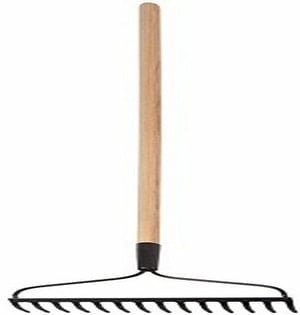
True temper offers both 14- and 16-tine bow rakes at the link above. They alternately list them by handle length and bow width. It’s honestly a bit confusing, but fortunately, the rake itself is a lot better than the way they advertise it there.
The 48” wooden handle is made of hardwood. It’s very short, even if you’re the average male height. But it’s a quality piece that will hold up to normal yard work quite well.
The 14-tine rake is 14” wide. That means the tines are just over an inch apart. Still, they do a good jump breaking up balls of soil when needed.
True Temper products are made by Ames, so you may find a similar rake with the Ames brand name on it.
There is a steel ferrule to hold the head on. Like every rake we’ve seen, some people have issues with the head coming off. Our experience and that of the overwhelming majority of purchasers, though, has been positive. It also comes in at a great price, which doesn’t hurt either.
Conclusion
When you need to rake through grass, break up soil, or spread soil or stone, a bow rake is the tool you need. Be sure to get one that has the right-sized handle, a tough head, and strong welding holding them together. Be careful about using it for tasks beyond what it’s intended for, though, as it could easily come apart from too much stress.

